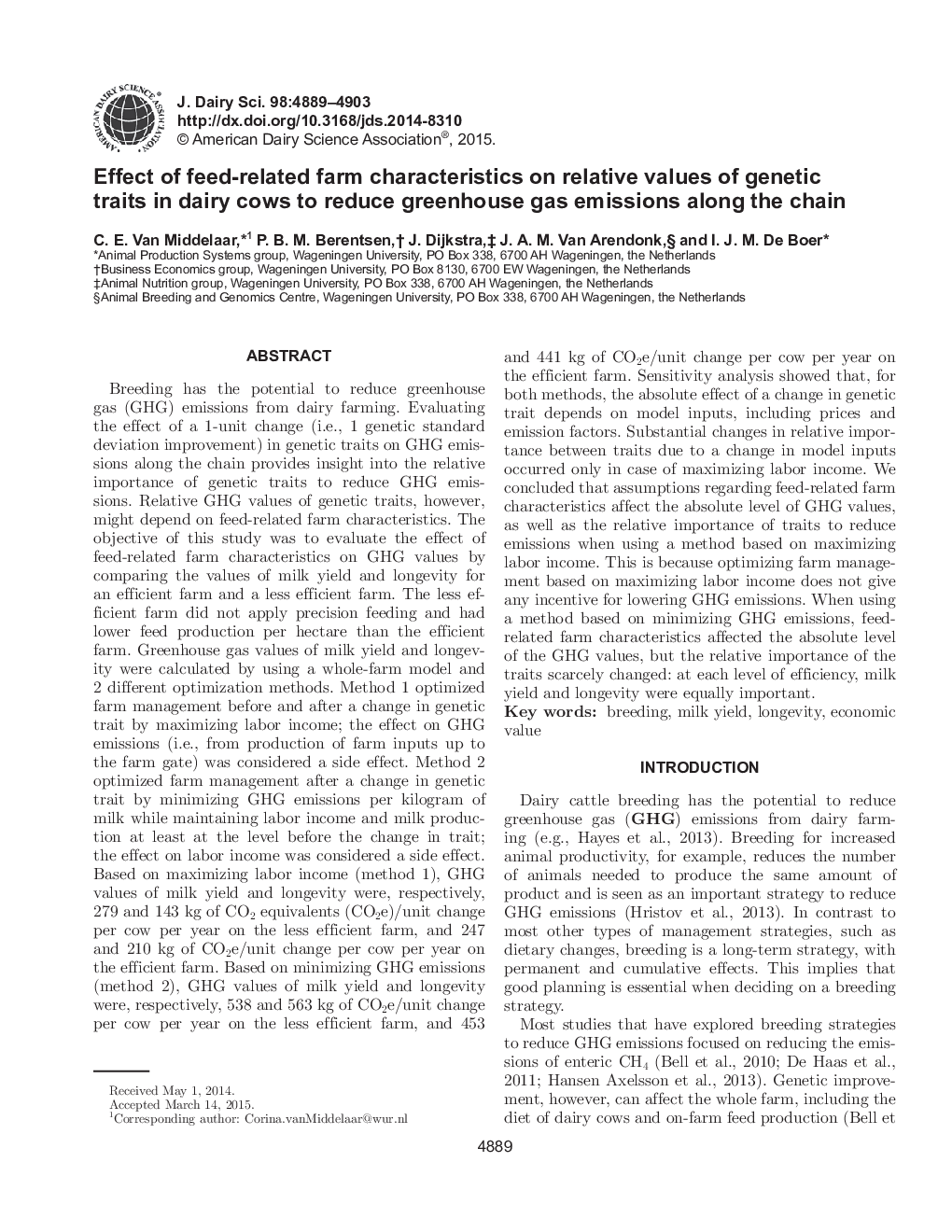| کد مقاله | کد نشریه | سال انتشار | مقاله انگلیسی | نسخه تمام متن |
|---|---|---|---|---|
| 10975323 | 1108032 | 2015 | 16 صفحه PDF | دانلود رایگان |
عنوان انگلیسی مقاله ISI
Effect of feed-related farm characteristics on relative values of genetic traits in dairy cows to reduce greenhouse gas emissions along the chain
ترجمه فارسی عنوان
تاثیر خصوصیات مزرعه وابسته به تغذیه بر ارزش نسبی صفات ژنتیکی گاوهای لبنی جهت کاهش انتشار گازهای گلخانه ای در طول زنجیره ای
دانلود مقاله + سفارش ترجمه
دانلود مقاله ISI انگلیسی
رایگان برای ایرانیان
کلمات کلیدی
پرورش، عملکرد شیر، طول عمر، ارزش اقتصادی،
موضوعات مرتبط
علوم زیستی و بیوفناوری
علوم کشاورزی و بیولوژیک
علوم دامی و جانورشناسی
چکیده انگلیسی
Breeding has the potential to reduce greenhouse gas (GHG) emissions from dairy farming. Evaluating the effect of a 1-unit change (i.e., 1 genetic standard deviation improvement) in genetic traits on GHG emissions along the chain provides insight into the relative importance of genetic traits to reduce GHG emissions. Relative GHG values of genetic traits, however, might depend on feed-related farm characteristics. The objective of this study was to evaluate the effect of feed-related farm characteristics on GHG values by comparing the values of milk yield and longevity for an efficient farm and a less efficient farm. The less efficient farm did not apply precision feeding and had lower feed production per hectare than the efficient farm. Greenhouse gas values of milk yield and longevity were calculated by using a whole-farm model and 2 different optimization methods. Method 1 optimized farm management before and after a change in genetic trait by maximizing labor income; the effect on GHG emissions (i.e., from production of farm inputs up to the farm gate) was considered a side effect. Method 2 optimized farm management after a change in genetic trait by minimizing GHG emissions per kilogram of milk while maintaining labor income and milk production at least at the level before the change in trait; the effect on labor income was considered a side effect. Based on maximizing labor income (method 1), GHG values of milk yield and longevity were, respectively, 279 and 143Â kg of CO2 equivalents (CO2e)/unit change per cow per year on the less efficient farm, and 247 and 210Â kg of CO2e/unit change per cow per year on the efficient farm. Based on minimizing GHG emissions (method 2), GHG values of milk yield and longevity were, respectively, 538 and 563Â kg of CO2e/unit change per cow per year on the less efficient farm, and 453 and 441Â kg of CO2e/unit change per cow per year on the efficient farm. Sensitivity analysis showed that, for both methods, the absolute effect of a change in genetic trait depends on model inputs, including prices and emission factors. Substantial changes in relative importance between traits due to a change in model inputs occurred only in case of maximizing labor income. We concluded that assumptions regarding feed-related farm characteristics affect the absolute level of GHG values, as well as the relative importance of traits to reduce emissions when using a method based on maximizing labor income. This is because optimizing farm management based on maximizing labor income does not give any incentive for lowering GHG emissions. When using a method based on minimizing GHG emissions, feed-related farm characteristics affected the absolute level of the GHG values, but the relative importance of the traits scarcely changed: at each level of efficiency, milk yield and longevity were equally important.
ناشر
Database: Elsevier - ScienceDirect (ساینس دایرکت)
Journal: Journal of Dairy Science - Volume 98, Issue 7, July 2015, Pages 4889-4903
Journal: Journal of Dairy Science - Volume 98, Issue 7, July 2015, Pages 4889-4903
نویسندگان
C.E. Van Middelaar, P.B.M. Berentsen, J. Dijkstra, J.A.M. Van Arendonk, I.J.M. De Boer,
